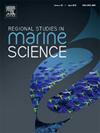The shift from resource utilization to optimal allocation of resources, capital, and labor: Analyzing China’s coastal fisheries economies
IF 2.4
4区 环境科学与生态学
Q3 ECOLOGY
引用次数: 0
Abstract
Exploring the impact of fishery resources on the fishery economy in China’s coastal areas through the “drag effect” of fishery resources is essential for promoting sustainable utilization, improving fishery quality, and addressing regional disparities in fishery development. Using panel data from 11 coastal provinces from 2007 to 2022, this study employs the time-varying CRITIC-entropy method to measure the fishery resource utilization index, empirically investigates the “drag effect” of fishery resources, and analyzes spatial effects using a spatial econometric model. The findings reveal that fishery resource input (R) significantly promotes the fishery economy and injects impetus for the sustained growth of the fishery economy; labor input (L) significantly constrains the fishery economy, probably due to excess inputs, which in turn constrains the production efficiency; and capital input (K) does not significantly affect the fishery economy, so it is necessary to focus on the balanced inputs of each factor. The “drag effect” of fishery resources varies significantly among provinces, categorized into low-promoting provinces (Zhejiang, Shanghai, Jiangsu, Tianjin, Guangdong), low-constraining provinces (Liaoning, Fujian, Hainan, Hebei, Guangxi), and high-constraining provinces (Shandong). Spatially, the “drag effect” is classified into three patterns: Low-Low (Shanghai), High-Low (Fujian), and no significant spatial effects. The “drag effect” of fishery resources in most provinces does not show significant spatial spillover effects. To ensure the sustainable and healthy development of the fishery economy, it is imperative to balance the input of fishery resources, capital, and labor, implement region-specific fishery development strategies, and strengthen cooperation among coastal regions to enhance resource utilization and reduce regional disparities.
从资源利用到资源、资本和劳动力优化配置的转变:中国沿海渔业经济分析
通过渔业资源的“拖曳效应”探索渔业资源对中国沿海地区渔业经济的影响,对于促进渔业可持续利用、提高渔业质量、解决渔业发展的区域差异具有重要意义。利用2007 - 2022年11个沿海省份的面板数据,采用时变临界熵法测度渔业资源利用指数,实证考察渔业资源的“拖曳效应”,并利用空间计量模型分析空间效应。研究发现:渔业资源投入显著促进渔业经济发展,为渔业经济持续增长注入动力;劳动投入(L)显著约束渔业经济,可能是由于投入过剩,进而约束生产效率;资本投入(K)对渔业经济的影响不显著,因此有必要关注各要素的均衡投入。渔业资源的“拖曳效应”在各省之间存在显著差异,可分为低促进省(浙江、上海、江苏、天津、广东)、低约束省(辽宁、福建、海南、河北、广西)和高约束省(山东)。在空间上,“阻力效应”表现为低-低(上海)、高-低(福建)三种模式,空间效应不显著。大部分省份渔业资源的“拖曳效应”不表现出显著的空间溢出效应。促进渔业经济持续健康发展,必须平衡渔业资源、资本和劳动力投入,实施因地制宜的渔业发展战略,加强沿海地区合作,提高资源利用水平,缩小区域差距。
本文章由计算机程序翻译,如有差异,请以英文原文为准。
求助全文
约1分钟内获得全文
求助全文
来源期刊

Regional Studies in Marine Science
Agricultural and Biological Sciences-Ecology, Evolution, Behavior and Systematics
CiteScore
3.90
自引率
4.80%
发文量
336
审稿时长
69 days
期刊介绍:
REGIONAL STUDIES IN MARINE SCIENCE will publish scientifically sound papers on regional aspects of maritime and marine resources in estuaries, coastal zones, continental shelf, the seas and oceans.
 求助内容:
求助内容: 应助结果提醒方式:
应助结果提醒方式:


